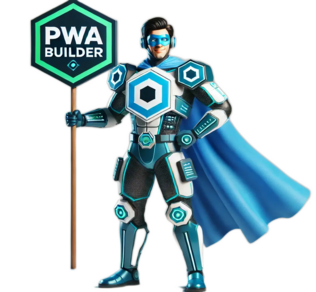PWA Builder Tool

Simplify Your Progressive Web App Development with the PWA Builder Tool
In the rapidly evolving landscape of web development, Progressive Web Apps (PWAs) have emerged as a game-changer. They bridge the gap between web and native apps, offering users an app-like experience directly from their browsers. If you’re looking to enhance user engagement and provide a seamless experience, integrating a PWA into your website is a strategic move. The PWA Builder Tool simplifies this process, allowing you to generate all the necessary files and configurations with ease.
What is a Progressive Web App (PWA)?
A Progressive Web App is a web application that leverages modern web capabilities to deliver an app-like experience to users. PWAs are reliable, fast, and engaging:
- Reliable: They load instantly, even in uncertain network conditions.
- Fast: They respond quickly to user interactions, with smooth animations and no janky scrolling.
- Engaging: They feel like a natural app on the device, with an immersive user experience.
“By adopting PWAs, you can enhance the performance of your website and provide features like offline access, push notifications, and installation prompts.”
Introducing the PWA Builder Tool
The PWA Builder Tool is an intuitive, user-friendly application designed to streamline the creation of PWAs. It eliminates the complexity of manually coding the essential components by generating them based on your inputs. Whether you’re a seasoned developer or new to PWAs, this tool empowers you to integrate progressive features into your website efficiently.
Key Features
- Manifest Generation: Automatically creates a
manifest.jsonfile, which describes your app and how it should appear to the user. - Service Worker Creation: Generates a
service-worker.jsfile to handle caching and offline functionality. - Icon Generation: Resizes and prepares app icons in various sizes to meet different device requirements.
- Customizable “Add to Home Screen” Prompt: Allows you to configure how and when users are prompted to install your app.
- User-Friendly Interface: Simple form inputs make it easy to specify app details without diving into code.
Why Use the PWA Builder Tool?
Simplify Development
Creating a PWA involves multiple steps, including configuring the manifest, setting up a service worker, and preparing assets like icons. The PWA Builder Tool automates these tasks, saving you time and reducing the potential for errors.
Enhance User Experience
By providing a seamless app-like experience, PWAs can significantly improve user engagement. Features like offline access and installation prompts make your web app more accessible and convenient.
SEO Benefits
“PWAs are indexable by search engines, which means your app can benefit from improved visibility. Additionally, faster load times and better performance can positively impact your site’s search ranking.”
How to Use the PWA Builder Tool
Step 1: Provide App Details
Fill out the form with your app’s information:
- App Name: The full name of your app, displayed to users.
- Short Name: A shorter version used where space is limited.
- Start URL: The entry point of your app (e.g.,
/index.html). - Display Mode: Choose how your app appears (standalone, fullscreen, minimal-ui, or browser).
- Theme Color: Defines the browser’s toolbar color when your app is launched.
- Background Color: Used on the splash screen when your app is loading.
Step 2: Upload Your App Icon
Upload a high-resolution image (minimum 512×512 pixels). The tool will generate icons in various sizes suitable for different devices.
Step 3: Customize the “Add to Home Screen” Prompt
Configure the installation prompt:
- Custom Message: A personalized message encouraging users to install your app.
- Prompt Timing: Decide when the prompt appears (immediately, after a delay, or on user interaction).
- Delay Time: If you choose a delayed prompt, specify the time in seconds.
Step 4: Generate PWA Files
Click the “Generate PWA Files” button. The tool will process your inputs and create:
- manifest.json
- service-worker.js
- Icons in a ZIP file
Step 5: Download and Implement
Download Files: Save the generated files to your computer.
Place Files in Your Website: Add manifest.json, service-worker.js, and the icons to your website’s root directory.
Step 6: Update Your Website’s HTML
Add the following code snippets to your HTML files:
<!-- Manifest and Theme Color -->
<link rel="manifest" href="manifest.json">
<meta name="theme-color" content="YOUR_THEME_COLOR">
Replace YOUR_THEME_COLOR with the theme color value you chose.
<script>
if ('serviceWorker' in navigator) {
navigator.serviceWorker.register('/service-worker.js')
.then(function() { console.log('Service Worker Registered'); });
}
</script>
<script>
let deferredPrompt;
window.addEventListener('beforeinstallprompt', (e) => {
e.preventDefault();
deferredPrompt = e;
// Custom behavior based on your settings
// For example, show the prompt immediately:
if (deferredPrompt) {
deferredPrompt.prompt();
deferredPrompt.userChoice.then((choiceResult) => {
console.log(choiceResult.outcome);
deferredPrompt = null;
});
}
});
</script>
Modify the script according to the prompt timing you selected.
Testing Your PWA
After implementing the files and updating your HTML:
- Access Your Website: Visit your website using a supported browser (e.g., Chrome on Android).
- Install the App: Verify that the installation prompt appears as configured.
- Launch from Home Screen: Install the app and launch it from your device’s home screen.
- Check Offline Functionality: Turn off your internet connection to test if the app loads offline.
Best Practices for PWAs
Ensure your PWA provides the best experience:
- Serve Over HTTPS: PWAs require a secure origin. Ensure your website has an SSL certificate.
- Optimize Performance: Use lazy loading, minimize HTTP requests, and compress assets.
- Regular Updates: Keep your service worker and assets up-to-date to provide the best user experience.
Quick Summary
- Manifest Generation
- Service Worker Creation
- Icon Generation
- Customizable Install Prompt
- User-Friendly Interface
- SEO Benefits
Conclusion
The PWA Builder Tool is an invaluable resource for developers aiming to enhance their web applications with progressive features. By automating the creation of essential files and configurations, it allows you to focus on building engaging content and functionality for your users.
Embrace the future of web development by integrating PWAs into your strategy. With improved performance, engagement, and SEO benefits, you’re set to deliver an exceptional user experience.
![]()

